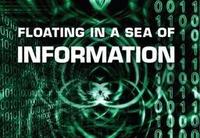Floating in a Sea of Information
In the Information Age of Internet and communications, all of us know how to use, get, and share information. But does anyone know where all this information is coming from?
We are living in the Information Age, when our careers, savings, and life decisions often depend on this amorphous thing that we can neither see, touch, hear nor smell. Information flows around the world almost instantly, but as the recent financial crisis has made clear, information assets - such as stock values that exist only as bits in a computer - can vanish overnight without a trace.
So what is this thing called “information?” Where does it come from, how do we get it, and what do we do with it once we have it?
Information – a Brief History
Information made its big debut with the rise of the Internet. People all around the world suddenly had free access to information, whether on world events, national news, foreign lifestyles, history, health, or new social networks.
It quickly became commonplace for people to use information exchange via the Internet to connect with others. For example, in 2006, a music video was posted on YouTube documenting a campaign called “Free Hugs,” held in Sydney, Australia, which involved giving away hugs to whomever wanted them. With the help of the Internet, people from Russia, China, US, South America, Israel, Portugal and everywhere else in the world joined this newly created movement and went out to crowded places offering “Free Hugs” to all takers.
Such instantaneous transmission of information around the world may have been mind-boggling 100 years ago, but it’s something we take for granted today. We have grown up in a world of telephones, radio, television, computers and internet. Yet with all the advances that have been made in information dissemination and acquisition, we still have very little knowledge about the real nature of information.
The Science of Information
Among the numerous scientists attempting to delve into the essence of information and the workings of the human mind, New Yorker columnist James Surowiecki coined the term, “the wisdom of crowds.” His research revealed that when many people work together to reach a conclusion, the result is better than any one of them could have come up with alone.
Moreover, if you ask a group of people to make a guess about something they know nothing about, the average answer of the group will be more accurate than when just one person was asked.
One of the most famous examples of this occurred at a livestock fair in the early 1900s. Over 800 fairgoers guessed the weight of an ox. No one guessed the exact weight, yet the average of all the guesses was off by only one pound!
What is it about groups that enables them to tap into information no single person could produce? And perhaps more interestingly, how do any of us come up with the information that we “know” in the first place?
The attempt to get to the heart of this question has given rise to yet another field of research, the study of memory. Yet the more it is studied, the more elusive memory becomes – to the point that some researchers now suggest that memory does not reside in the brain at all!
Biologist Rupert Sheldrake theorizes that memories are not stored anywhere in our bodies, but in a field called “morphic resonance” - a field of information surrounding us. The brain is merely a “tuner” that taps into this field and brings the desired information to our consciousness. In his own words, “Each individual both draws upon and contributes to the collective memory of the species.”
A Sea of Knowledge
Through the study of information, science is now beginning to discover what the wisdom of Kabbalah has known for thousands of years: that we are all part of one, interconnected entity, or an “information bank,” if you will. Each and every one of us is “floating” in this sea of information, whether we realize it or not.
It lies beyond the bounds of time and space, and contains everything that ever has or will be known. For example, have you ever seen a flock of birds fly in the air, and suddenly make a turn in unison? How do they know that they need to turn? It’s because they receive their information from one place.
It’s the same with all parts of nature. Physics is discovering that elementary particles immediately “inform” one another about any changes happening to them. Similarly, each of us is connected to a common information field, albeit unconsciously. Everything “new” that we learn already exists around us – all we have to do is tune in to it and feel our existence in this sea of information, which is beyond time, space or motion. Then we will experience a life of eternity, perfection, and boundless wisdom.
This sea of knowledge explains all the informational phenomena in our world: the rapid spreading of the Free Hugs campaign, “the wisdom of crowds,” and the morphic resonance phenomena. However, the common information field has a far higher purpose than simply to intrigue scientists. It holds the key to our future: the opportunity for us to consciously feel that we are all connected as a common entity, and thereby feel the perfection of unity.
